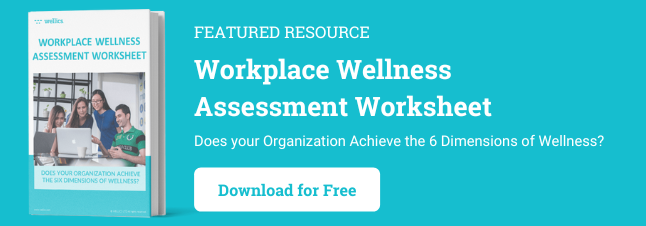Social wellness is integral to a person’s mental, emotional, and physical health. People with high levels of social well-being often feel more fulfilled in their work and relationships and tend to develop healthy skills, like assertiveness and conflict resolution. That’s why effective employee wellness programs emphasize ways to measure and enhance social well-being at work.
When it comes to the workplace, social wellness is critical to producing united teams that work together collaboratively. Our guide to social wellness activities can help organizations boost employee engagement, including fostering inclusivity and well-being among minority groups in the workplace, such as those identifying as LGBTQ+.
What Is Social Wellness?
Social wellness is a measure of the quality of someone’s ability to build and maintain constructive relationships with others. In the traditional social wellness definition, psychologists look at a person’s relationships with their family, friends, coworkers, and broader community members to assess social well-being.
Why is social wellness important? How well a person relates to people in their lives affects their personal sense of fulfillment and well-being.
The social dimension of wellness is one of at least six elements of health and wellness that contribute to a person’s overall well-being. Social wellness interacts with other dimensions of wellness, including mental, emotional, and spiritual well-being.
Why Is Social Well-Being Important in the Workplace?
While social well-being is a vital dimension of wellness for everyone, it’s essential in the workplace. Social wellness in the workplace helps build a dynamic and cohesive team of employees who feel engaged in and satisfied with their work.
Social wellness benefits for the workplace include:
- Contributes to career success
- Builds stress-management skills
- Reduces risk of health issues
- Boosts emotional resilience
Fostering social well-being at work can help drive organizational success thanks to improved employee morale, better worker retention, and reduced employment costs, including lower healthcare expenditures.
11 Social Wellness Activities at Work
Organizations looking to improve social wellness in the workplace can develop programs, contests, and activities that bring teams together and drive this critical element of wellness at work.
What are examples of social wellness? Below are 11 types of social wellness activities for the workplace:
1. Group-guided meditations
Mindfulness meditation is an evidence-based way to improve stress-coping skills, helping people thrive in the workplace. Findings also suggest that mindfulness meditation improves empathy and collaboration. Group-guided meditations at work can help team members build deeper awareness, support, and understanding of each other.
2. 5k runs for charity
Many people participate in 5k runs on their own time, but incorporating these events into the workplace can help boost individual social well-being and team building. Create your own 5k fundraiser for charity or find a local Run for Charity near you.
3. Sports clubs
For larger workplaces, sports clubs can help promote social wellness and friendly competition. Whether it’s basketball, volleyball, or floor hockey, sports are a proven way to enhance psycho-social health.
4. Fitness challenges
Workplace fitness challenges are a fun and effective way to boost individual and team wellness. Workplace challenges can include step challenges, water challenges, or cycle-to-work contests. You can run a variety of different challenges on an ongoing basis to make social wellness activities accessible to as many employees as possible.
5. Work anniversary celebrations
One of the simplest ways to cultivate better social wellness in the workplace is to celebrate each employee's work anniversary. Send out announcements or organize a lunch-time get-together to help recognize employees while encouraging a social element.
6. Peer acknowledgments
Peer acknowledgments are a popular way to boost social wellness and employee engagement at work. Encouraging employees to recognize their coworkers for their efforts, support, creativity, or other contributions builds stronger teams and a lively workplace culture.
7. Team-building activities
Workplaces interested in improving social wellness can make time for team-building activities. Icebreakers, like “two truths and a lie,” and other social wellness games allow coworkers to spend time together outside of their usual duties so they can work better together.
8. Volunteer days
One of the most beneficial social wellness group activities is volunteering with your team. Volunteering offers numerous social health benefits, including expanding your social network, practicing social skills with others, and strengthening existing social bonds, such as with coworkers.
9. Team lunches
Build an inclusive and socially thriving workplace with team lunches. Have your HR or management team organize regular team lunches that allow employees to spend time together enjoying good food. Incorporate career development by hosting lunch-and-learns that cover various topics related to the job.
10. Book clubs
Workplace book clubs offer a variety of wellness benefits, including boosting social connections and promoting learning and development. Organize a bi-monthly or quarterly book club where team members can get together and discuss the topic. Choose books related to your industry or change up the genres each time.
11. Company retreats
Bolster social wellness across your entire organization with a company retreat. Company retreats unite the organization by combining a variety of activities, from learning and training sessions to team-building exercises to time for informal socializing. Teams leave their company retreat feeling inspired and engaged, leading to improved productivity and enhanced creativity.
Tailor any of the above social wellness examples to your organization’s unique human resources needs. When planning social wellness activities at work, be sure to consider how to maximize the inclusivity of employees belonging to minority groups or demographics that may otherwise face discrimination based on race, gender, sexual orientation, or religious beliefs.
Prioritizing social inclusivity can help improve the overall well-being and productivity of all members of your team.
Improve Social Well-Being at Work With Employee Wellness Programs
Maximize social well-being in the workplace with employee wellness programs designed to engage, optimize, and include all workplace members. Building an inclusive employee wellness program that emphasizes social well-being can help foster personal wellness and improved productivity among members of commonly marginalized groups.
With the Wellics wellness platform, your organization can reach its workplace social wellness goals. Using Wellics, your organization can implement, track, and optimize social well-being programs in the workplace. Set custom metrics and monitor each employee's social well-being, as well as the social well-being results of your entire organization. Discover how to improve social wellness and enjoy a healthier, happier, and more productive workplace for all with the Wellics employee wellness program.
Originally published June 21, 2022 - 6:19 AM, updated September 3, 2024
Sources
- https://www.inc.com/dana-severson/after-studying-lives-of-724-men-for-79-years-harvard-reveals-1-biggest-secret-to-success-happiness.html
- https://www.cdc.gov/aging/publications/features/lonely-older-adults.html
- https://www.ncbi.nlm.nih.gov/pmc/articles/PMC2921311/
- https://www.apa.org/topics/mindfulness/meditation
- https://www.ncbi.nlm.nih.gov/pmc/articles/PMC7139462/
- https://hbr.org/2019/05/what-mindfulness-can-do-for-a-team
- https://runforcharity.com/
- https://ijbnpa.biomedcentral.com/articles/10.1186/1479-5868-10-98
- https://www.mayoclinichealthsystem.org/hometown-health/speaking-of-health/3-health-benefits-of-volunteering









